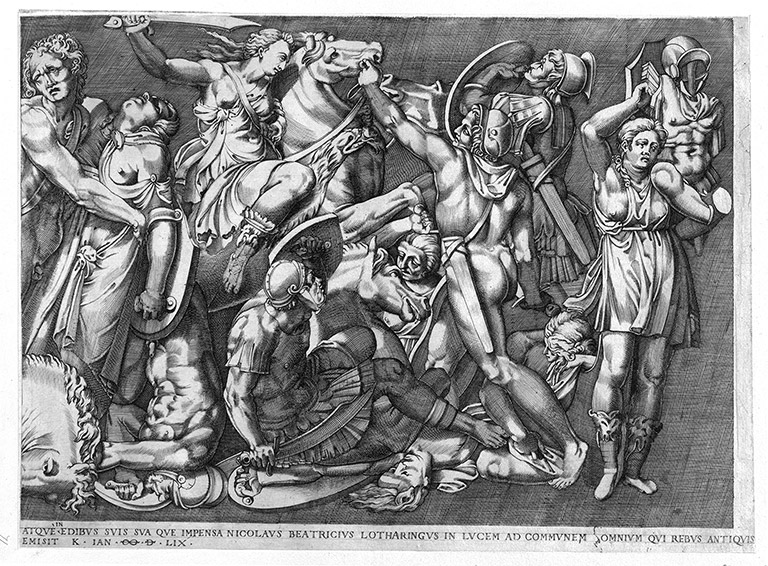
Engraving “Battle of the Amazons,” from Speculum Romanae Magnificentiae, by Nicolas Beatrizet. Donated to Wikimedia Commons by the Metropolitan Museum of Art.
Planet of the Amazon Women
Strange Horizons, May 2005. Reprinted in The Year’s Best Science Fiction: Twenty-Third Annual Collection, edited by Gardner Dozois. New York: St. Martin’s Griffin, 2006. ISBN 978-0312353346 (tpb), 978-0312353359 (hc). Reprinted in The Mammoth Book of Best New SF 19, edited by Gardner Dozois. London: Robinson, 2006. ISBN 978-1845294236 (tpb), 978-1780337180 (ebook).Once upon a time, the world called Hippolyta had been a model Consilium protectorate, thoroughly terraformed, spookily Earthlike, home to something under three billion humans. It was peaceful, relatively prosperous, largely self-governing. Its sizable Muslim population sent a million pilgrims to Earth every year.
Then one day, every man on Hippolyta died.
Every male animal.
Every male ginkgo, date palm, malarial gametocyte.
Most of the victims of the syndrome that came to be called Amazon Fever died within thirty-six hours after the first symptoms, which were those of a massive autoimmune reaction. The Fever left hundreds of millions of mothers without sons, daughters without fathers, wives without husbands, sisters without brothers. Then came the Consilium’s quarantine, to kill millions of those the plague had spared: so many million dead of starvation, so many million suicides, so many millions killed in riots, insurrections, little wars. So many tens of millions lost to diseases that should have been treatable.
So many born into a generation with no future, doomed to die behind walls, and alone.
But the women who made it through the first few years lived. The girls who made it through the first few years grew up. And when they grew up they had—no one could say how—daughters of their own. Knocked back to a twentieth-century existence of subsistence farming, industrial pollution, and nasty socio-ethno-economic wars, Hippolyta’s women survived.
Now there have been four generations born on Hippolyta, of women who were not the children of men. And still every man who has landed on Hippolyta since the Fever has died.
But Sasha Rusalev—dancer, mathematician, philosopher—thinks he has a cure.
If Rusalev is right, Amazon Fever could change the world.
If he’s wrong, Amazon Fever will kill him.
In the thirteenth and fourteenth centuries of the Hegira, before my ancestors came to Islam, they flirted briefly with Hegel. Perhaps in hoping, by resolving the contradictions of Hippolyta, to resolve the contradictions at the heart of the universe, I have fallen into that old heresy: thesis, antithesis, synthesis. If so, so be it. As a natural philosopher, I am expected to face up to the universe's hard truths. As a Russian, I am expected to be a fatalist and a romantic. As a Moslem, I am expected to place my faith in the All-Merciful.
To deny the contradictions—as Musa understood, and as I would never be able to explain to Lieutenant Addison—is not an option that is open to me.